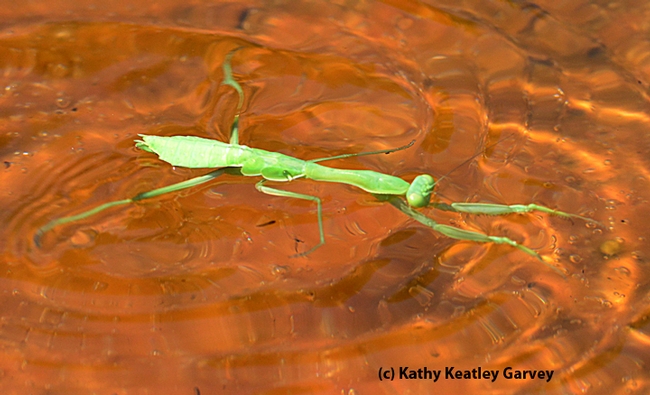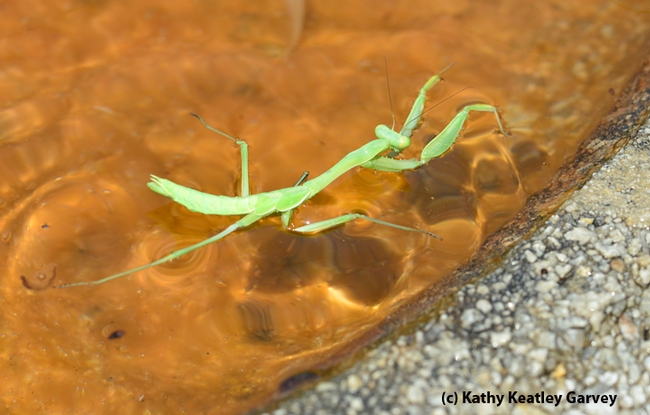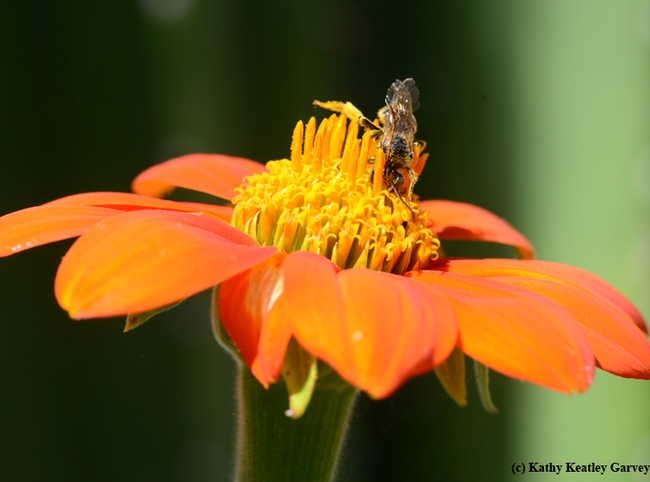- Author: Kathy Keatley Garvey

It's true. You can't put a limit on anything.
The praying mantis, aka Lean Green Machine, dived off the high board, did a reverse 3-1/2 double somersault with 1/2 twist and swam to the edge of the Olympic-sized pool. He gingerly lifted himself out of the water as a cheering spectator handed him a bouquet of red roses.
Well, it didn't happen quite that way.
The praying mantis entered our shallow birdbath—maybe a baptismal ceremony?—and using his best dog-paddle, praying-mantis stroke, swam across the birdbath. Then he leaped onto a yellow rose occupied by a bee.
Maybe he was simply “wetting” his appetite (er, “whetting” his appetite).
Fish swim. Crocodiles swim. Snakes swim. Dogs swim. Cats swim. And praying mantids swim.
Praying mantids are observant critters. They know where to go for breakfast, lunch and dinner and a few snacks in between. A bee garden is their supermarket, a veritable one-stop shopping experience. No carts, credit cards or courtesy calls needed.
Praying mantids are so camouflaged that you rarely see them. But when you're watering the plants in the early morning, a spray of water will prompt them to emerge. Displeased and disgruntled. Peeved and perturbed. Kicking and kvetching. This is no "Good-morning-sunshine!" kind of greeting.
In our family bee garden, they perch on the Mexican sunflower (Tithonia) and lie in wait for prey. You'll see them swiveling their heads at 180 degrees as they patiently wait to ambush an unsuspecting bee or butterfly. Their spiked forelegs ensure there's no escape.
We've all heard that a female praying mantis will sometimes behead and eat her mate. We've all heard that the hundred or so nymphs that hatch from the egg case will eat their brothers and sisters. They've been doing this for 150 million years or so.
Some teachers keep praying mantids in their classroom. Some folks keep praying mantids as pets. We think we'll train ours to be the insect version of Olympic swimmer Michael Phelps, who medaled 22 times, 18 of them gold.
The Lean Green Machine already knows how to do the one-meter butterfly. That would be the Western tiger swallowtail (Papilio rutulus) and the skipper (Hylephila phyleus).



- Author: Kathy Keatley Garvey
No, no, no, you got it all wrong!
I said “Please don't eat the pollinators! No butterflies and no bees. Eat the flies, gnats, mosquitoes, aphids and stink bugs. No butterflies or bees.”
Sadly, the praying mantis in our family bee garden does not listen to me. On Thursday morning, July 31 the praying mantis snagged and devoured a Western tiger swallowtail that made the fatal mistake of landing on his Mexican sunflower (Tithonia)
On Sunday morning, Aug. 2, while perched on the same flower, the praying mantis polished off a honey bee.
I was walking through the garden at the time but never saw the strike. One second he's lying in wait, and the next second, his powerful forelegs are gripping a honey bee.
You don't want to know what happened after that.
Still, I wonder...did the honey bee manage to sting him?



- Author: Kathy Keatley Garvey
If you have Mexican sunflowers (genus Tithonia) in your garden, you can expect a diversity of insects--and not just honey bees.
Lately we've been photographing all the insects that visit the Tithonia in our bee garden.
They include butterflies (including monarchs, Gulf Fritillaries, skippers and cabbage whites) bumble bees (Bombus vosnesenskii and Bombus fervides, formerly known as Bombus californicus), sweat bees, leafcutter bees, long-horned bees, praying mantids, honey bees, carpenter bees, and yes, flies (green bottle fly).
The Mexican sunflower, an annual in the sunflower family, Asteraceae, originates from Mexico and Central America. What's good about the Tithonia--besides its sizzling color and its ability to attract a diversity of insects--is that it's drought-tolerant. That's especially important as we thirsty Californians endure our worst-ever drought.
We grew our Mexican sunflower (Tithonia rotundifolia) from seed, and it should bloom all summer. Already it's reaching NBA basketball-stature--topping seven feet in height.
We may have to set up a orchard ladder in our bee garden on our next photo shoot!





- Author: Kathy Keatley Garvey
Just call it "The Battle Over the Tithonia."
A female monarch butterfly--gender identified by butterfly expert Art Shapiro, professor of evolution and ecology at the University of California, Davis and Lynn Kimsey, director of the Bohart Museum of Entomology--fluttered into our bee garden early this morning and dropped down on a Mexican sunflower (Tithonia).
Her landing was perfect. The monarch (Danaus plexippus), a species that Sharpio rightfully says "requires no description"--claimed her flower as several male long-horned sunflower bees, Melissodes agilis, began targeting her.
Talk about a friendly "welcoming party." Not!
Those Melissodes agilis aren't called "agile" Melissodes agilis for nothing.
The monarch zipped over to another Tithonia, only to be trailed by the Melissodes dive bombers.
After foraging on her third flower and failing to evade the tactical squad, the monarch apparently figured it just wasn't worth her efforts.
Off she went, escorted out of the bee garden by the bomb squad.



- Author: Kathy Keatley Garvey
"Summertime, and the livin' is easy," belted out Ella Fitzgerald.
She wasn't singing about bees, but she could have been.
Summertime, and the livin' is easy
Fish are jumpin' and the cotton is high
Oh, your daddy's rich and your ma is good-lookin'
So hush little baby, Don't you cry.--George Gershwin.
Not always so easy if you're a sunflower bee (Melissodes agilis) foraging on a Mexican sunflower (Tithonia).
Here you are, nearly tangled in a thicket of yellow pollen. You're absorbed. Totally. In fact, you're absolutely oblivious to your surroundings.
Suddenly, you feel as if you're being watched. Watched. Targeted. Bombarded.
Fact is, you are.
Off in the distance, another male bee is speeding straight toward you in the proverbial beeline maneuver in a territorial war.
Pull up! Pull up! Ground proximity warning system.
Whew! That was a close one.





